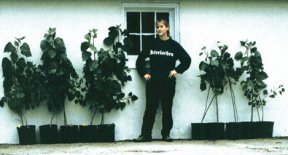City trees beat country trees
Cottonwood trees grow better in New York City than in rural places around the state.
By Emily Sohn
There are city people, and there are country people. Now, the same may be true for trees.
A common type of tree grows twice as well in New York City as it does in rural places around the state, researchers report. An unexpected twist in pollution patterns appears to explain the trend.
 |
|
Plant ecologist Jillian Gregg with cottonwood trees grown in the city (left) and in the country (right).
|
| Cornell University |
Cities may seem like an unlikely place for plant life to blossom. Car fumes, polluted water, and toxic metals in dirt are only a few of the obstacles to growth.
That’s why ecologist Jillian Gregg’s results were somewhat surprising. She and her colleagues found that Eastern cottonwoods planted in the heart of New York City grew to be twice as massive as trees planted in small towns outside the city.
The researchers were able to rule out genes, light conditions, rainfall, bugs, temperature, carbon dioxide levels, and soil type as causes.
However, they noticed that one type of air pollution—the amount of ozone in air averaged over a 24-hour period—was actually worse in the country than in the city. Much of that ozone came from pollution blowing in from urban areas. Back in the city, though, other abundant air pollutants were clearing out the ozone by combining with it chemically and making it harmless.
The study shows how much city pollution can hurt rural environments. And just like people, even trees suffer from the city’s bad breath.







